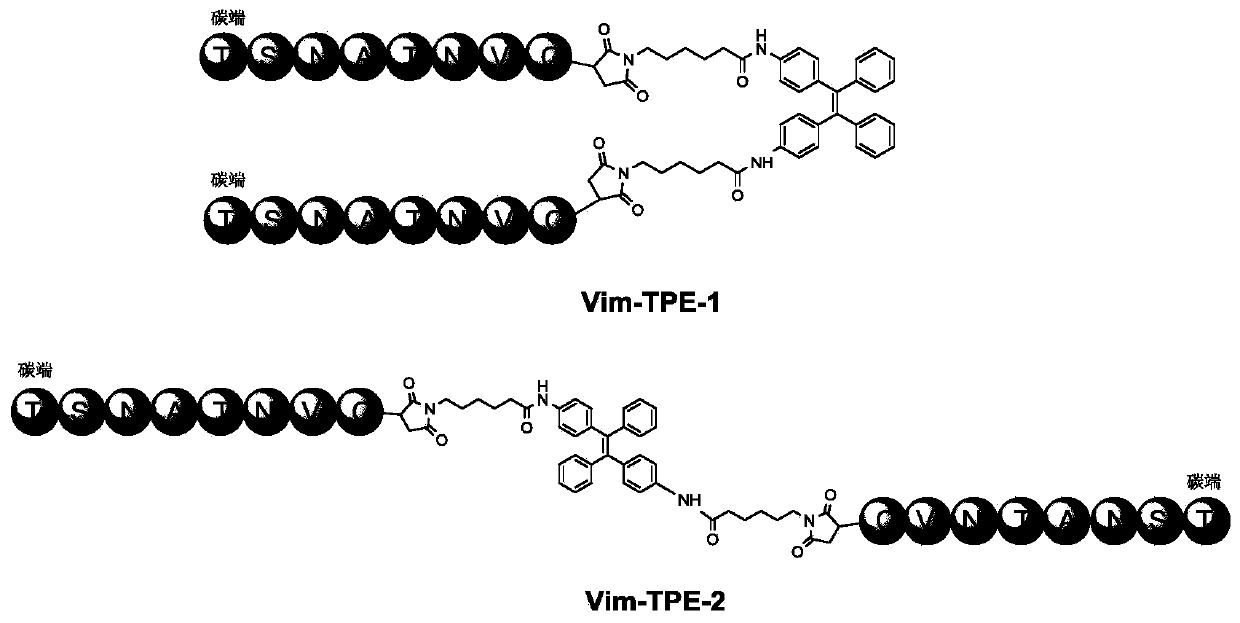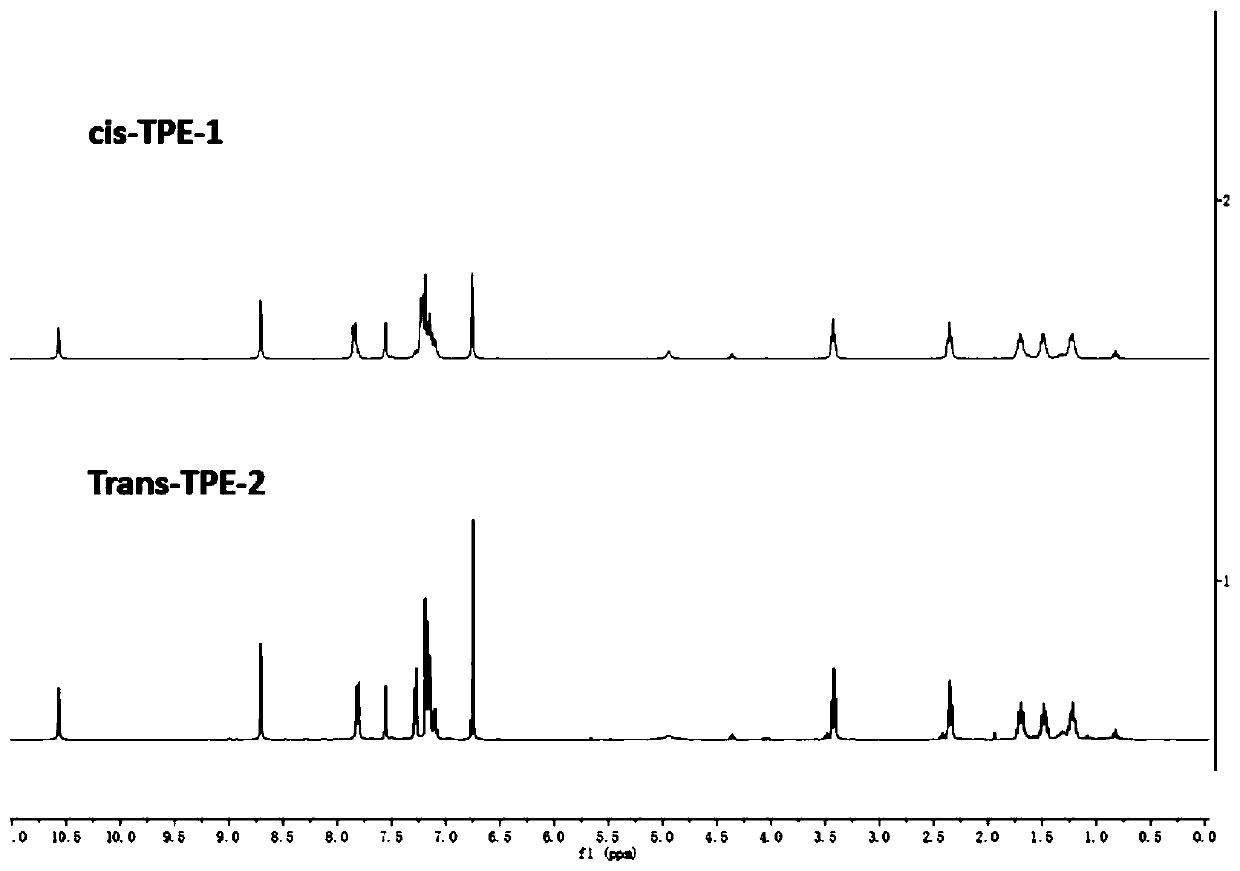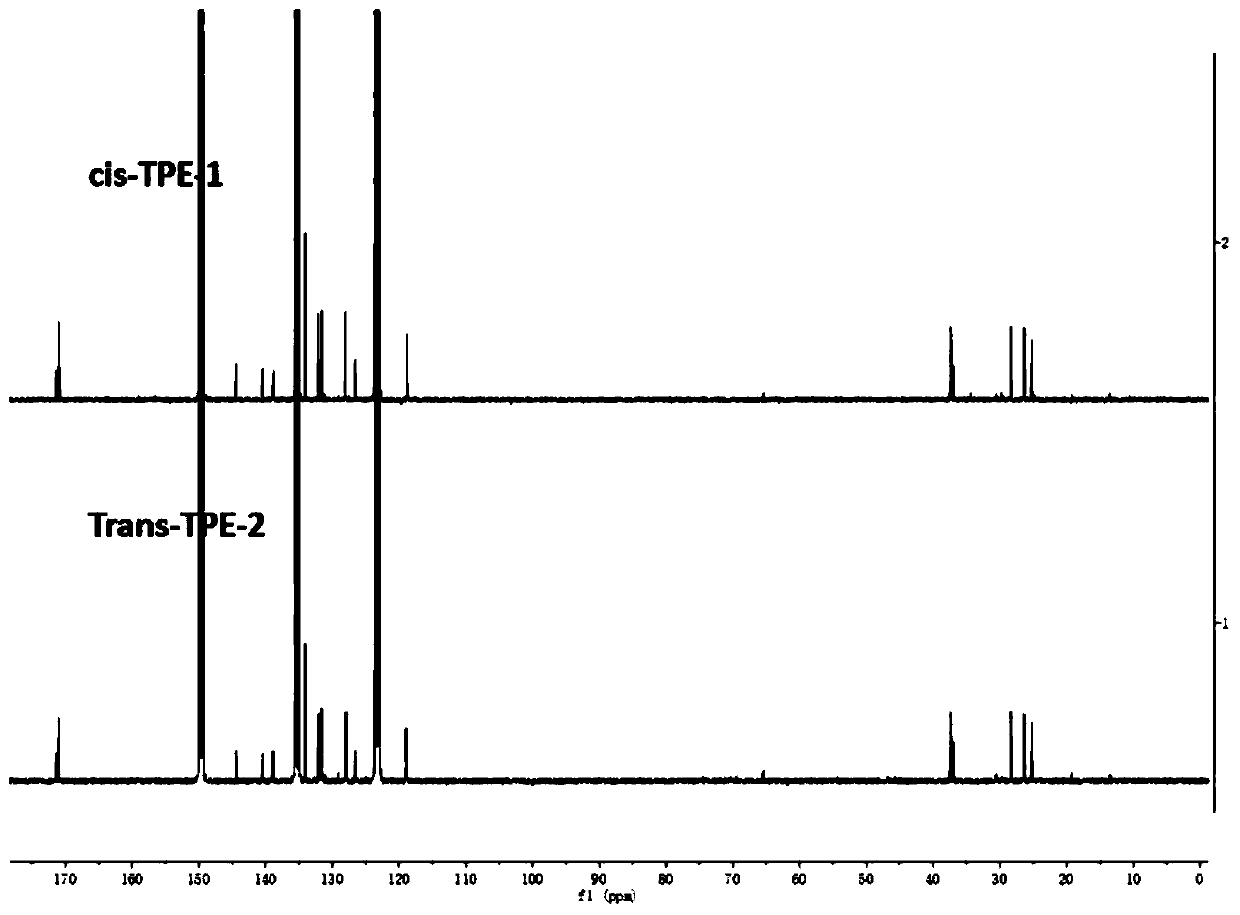Waveform protein response type wash-free fluorescent probe as well as preparation method and application thereof
A technology of vimentin and fluorescent probes, which is applied in the field of vimentin-responsive wash-free fluorescent probes and its preparation, can solve problems such as unsatisfactory specificity and accuracy, reduced detection sensitivity, and detection sample interference, and achieve high Sensitivity, low cost, guaranteed effect of charge interaction
- Summary
- Abstract
- Description
- Claims
- Application Information
AI Technical Summary
Problems solved by technology
Method used
Image
Examples
Embodiment 1
[0040] Such as figure 1 , Provide vimentin-specific responsive fluorescent probe vim-TPE-1 / 2, including aggregation-inducing luminescent fluorescent groups and peptides with affinity for vimentin, as well as the connecting group between the two.
[0041] The aggregation-induced luminescence fluorescent group is 1,2-diphenyl-1,2-bis(4-aminophenyl)ethylene.
[0042] The amino acid peptide fragment with affinity for vimentin contains the following sequence SEQ ID NO:1: CVNTANST.
[0043] The linking group between the aggregation-induced luminescent fluorescent group and the affinity peptide for vimentin is 6-maleimidohexanoic acid.
[0044] In a vimentin-specific responsive fluorescent probe molecule, the number of vimentin affinity peptides and linking groups is two each, and the relative position of the peptides is the cis or trans of the tetrastyrene double bond.
Embodiment 2
[0046] Synthesis of Vim-TPE-1 / 2 Specific Response Fluorescent Probe
[0047] See the following reaction formula (1):
[0048] (1)
[0049] Dissolve 1,2-diphenyl-1,2-bis(4-aminophenyl)ethylene (cis-trans isomer mixture, 200 mg, 1 equiv) in 10 ml dichloromethane, 6-maleimide Aminocaproic acid (350 mg, 3 equiv) and EEDQ (408 mg, 3 equiv) were added to the reaction solution to carry out the amide condensation reaction of the carboxyl group and the primary amine, and react at room temperature overnight. The solvent was spin-dried with a rotary evaporator, and petroleum ether: ethyl acetate 1:1 was separated by silica gel column to obtain two cis-trans isomer intermediates cis-TPE-1 156 mg and trans-TPE-2 25 mg, such as Figure 2-6 , By 1H NMR ( figure 2 ), 13C NMR ( image 3 ) COSY ( Figure 4 with Figure 5 ), NOESY ( Image 6 ) Two-dimensional nuclear magnetic resonance spectroscopy to determine the structure.
[0050] cis-TPE-1: 1H NMR (400 MHz, Pyridine-d5) δ 10.57 (s, 2H), 7.81 (d,...
Embodiment 3
[0063] Imaging detection of vim-TPE-1 and vim-TPE-2 on human lung adenocarcinoma cells NCI-H1975 and PC-9 cells
[0064] Human lung cancer cells NCI-H1975 cells and PC-9 cells were used as vimentin-positive and vimentin-negative model cells, respectively. Human lung adenocarcinoma cells NCI-H1975 cells and PC-9 cells were seeded at a density of 200,000 cells / well. In a six-well plate, after the cells adhere to the wall, wash the cells with buffer solution, and incubate them with 200μl 10 μM vim-TPE-1 and vim-TPE-2 at room temperature for 2h respectively, and observe the green color of the cells under a 40× field of view with a fluorescence microscope Fluorescence brightness ( Figure 14 , 15 ). The fluorescence imaging results of the two kinds of tumor cells showed obvious differences: NCI-H1975 tumor cells showed obvious green fluorescence, while PC-9 tumor cells had almost no fluorescence, indicating that vim-TPE-1 and vim-TPE-2 can distinguish EMT This result proves the appli...
PUM
 Login to View More
Login to View More Abstract
Description
Claims
Application Information
 Login to View More
Login to View More - R&D
- Intellectual Property
- Life Sciences
- Materials
- Tech Scout
- Unparalleled Data Quality
- Higher Quality Content
- 60% Fewer Hallucinations
Browse by: Latest US Patents, China's latest patents, Technical Efficacy Thesaurus, Application Domain, Technology Topic, Popular Technical Reports.
© 2025 PatSnap. All rights reserved.Legal|Privacy policy|Modern Slavery Act Transparency Statement|Sitemap|About US| Contact US: help@patsnap.com



